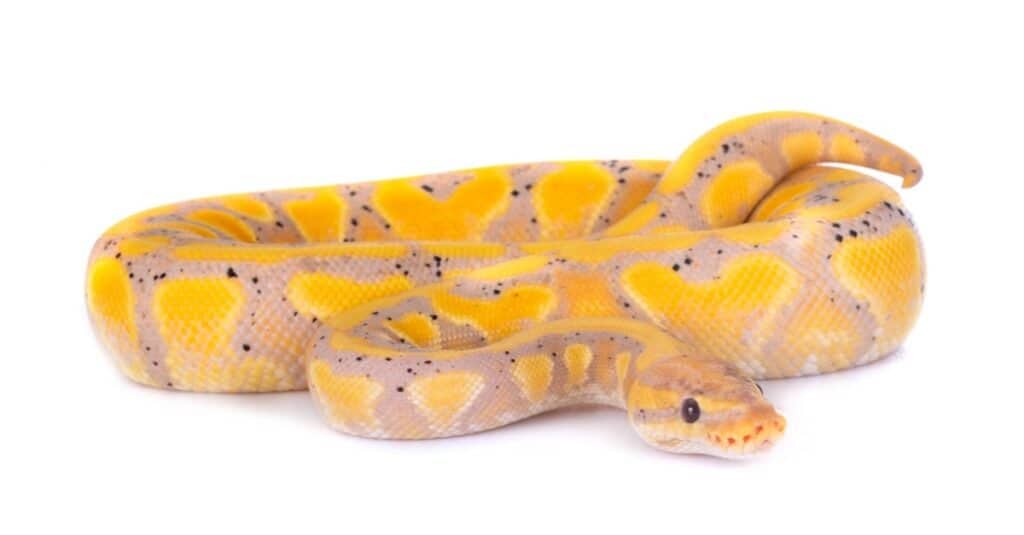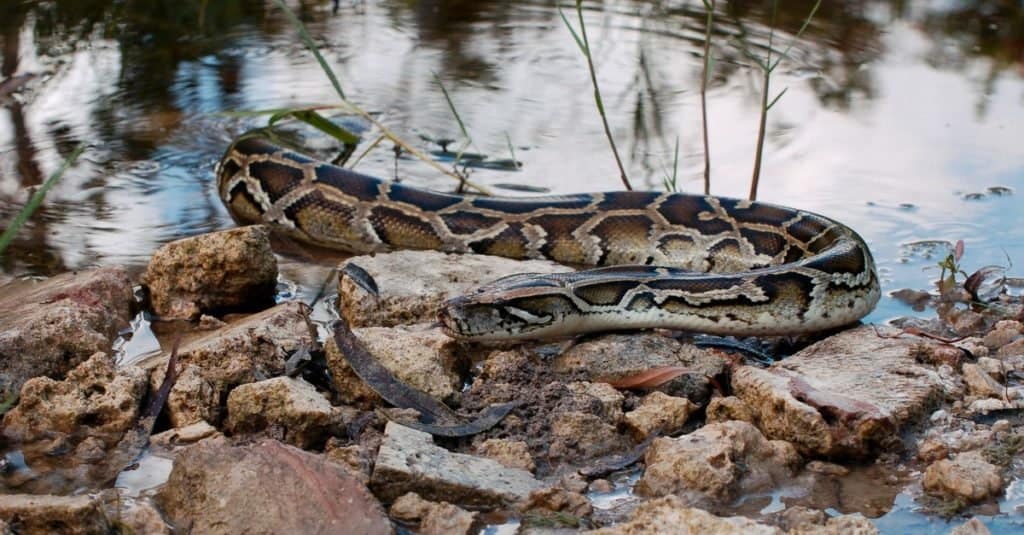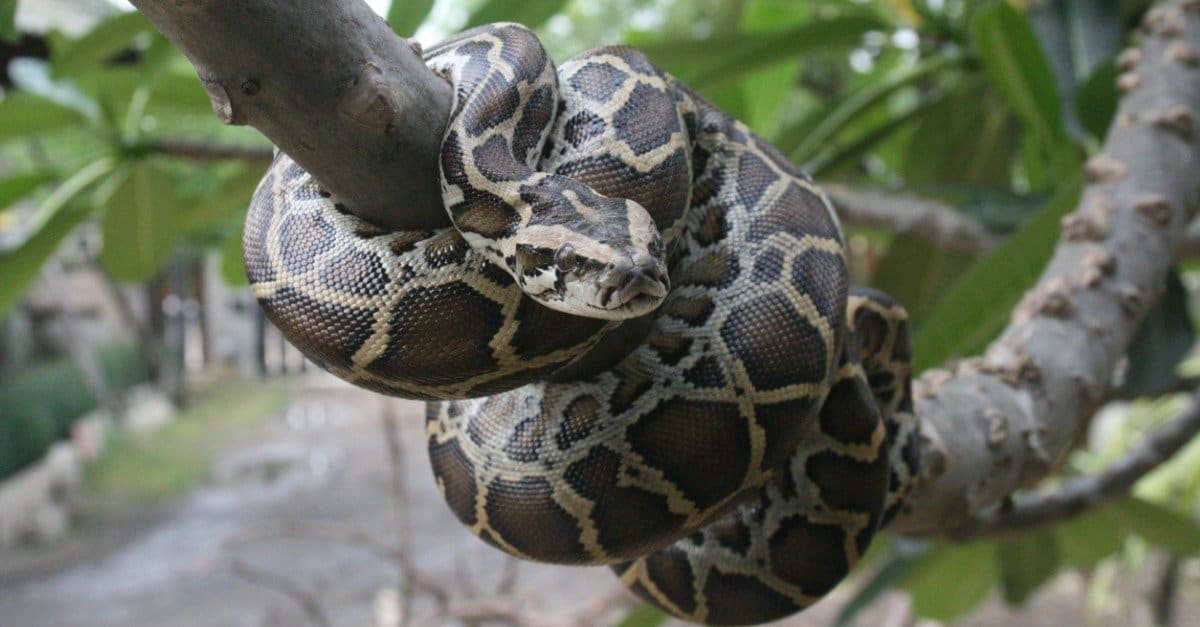A wide assortment of snakes exists in the world today. Sometimes they look very similar to one another, and other times they look very different. In the case of the Burmese python and the ball python, the two snakes share a name and a love for rodents. That’s where most of the similarities end. Today, we’re going to compare the Burmese python vs ball python and show you all their unique qualities.
When we finish, you’ll know what makes these two snakes distinct even though they stem from the same genus.
Comparing a Burmese Python and a Ball Python

| Burmese Python | Ball Python | |
|---|---|---|
| Size | Weight: 100 to 200 lbs Length: 10 to 16 ft | Weight: 3 to 7 lbs Length: 4 to 6 ft |
| Colors and Markings | – Tan base color – Angular dark brown splotches along the sides and back – Blotch patterns are giraffe-like and may seem to fit together – Head has a V-shaped splotch in dark brown with a thick tan line down the center – Has light tan ventral scales | – Dark background colors such as brown, gray, and black – Rounded markings that are light tan – Often has lighter color lines over its eyes – The ball python has many morphs or different colors that were developed by breeders – They’re very popular pets |
| Distribution | – Southeast Asia – India, Cambodia, Vietnam, China, Nepal, and many other countries – Invasive species in Florida, USA | – West Central Africa – Ivory Coast, Nigeria, Chad, Central African Republic, Mali, and more |
| Habitat | – Prefers to live near permanent water fixtures – Near swamps, rivers, rainforests, marshes, and other areas | – Lives in savannahs and grasslands |
| Diet | – Rats, birds, foxes, alligators, raccoons, birds, dogs, goats, and more | – Birds and small mammals – Rats and mice are especially popular meals |
The 5 Key Differences Between a Burmese Python vs Ball Python

Ball pythons are very common pets.
©Sergey Novikov/Shutterstock.com
The biggest differences between a Burmese python and a ball python lie in their size and color. The Burmese python is a snake with a tan base color and dark brown blotches that measures between 10 and 16 feet long and weighs up to 200 pounds. The ball python is a snake with dark colors with light blotches that weighs between 3 and 7 pounds and measure up to 6 feet tall.
These are the main differences between the snakes, but they’re not the only ones. We’ll take a closer look at the five characteristics that set them apart.
Burmese Python vs Ball Python: Size
Burmese pythons are larger than ball pythons. An average Burmese python will weigh up to 200 pounds and measure 16 feet long, but the ball python grows to about 6 feet long at most and weighs about 7 pounds.
The largest Burmese python was even larger, measuring 18 feet and weighing over 200 pounds. Needless to say, size is a major difference between these two snakes.
Burmese Python vs Ball Python: Colors and Markings

The
banana ball python
is easily identified by its bright yellow markings.
©iStock.com/cynoclub
At first glance, a Burmese python and a ball python make look similar. However, their colors and markings give them away. For example, the Burmese python has a tan base color while the ball python usually has a dark base or background color like gray, brown, or black.
The Burmese python has dark blotchy patterns on its scales in dark brown or black. These blotches have angular edges to them and look like puzzle pieces that would fit together. Yet, the ball python has light markings on its scales, and they are rounded on the edges.
The Burmese python has a V-shaped dark splotch on its head with a thick tan line running through it. That is not present on the ball python. However, the ball python has light color markings around its eyes.
It’s easy to look at these snakes and let their similar colors play tricks on your brain so that you think they look alike. If you spend a few seconds looking at one and then the other, you’ll see that they’re very unique.
Since the ball python is a popular pet, they have been bred to exhibit many colors. Dozens of different ball python morphs exist today. Reptile owners can find them in all sorts of colors and varieties.
Burmese Python vs Ball Python: Distribution
The Burmese python is found in Southeast Asia and the Indian subcontinent. These snakes are commonly found in India, Cambodia, China, and many other countries. They are also an invasive snake species in the United States. The Burmese python has made a home in Florida, and it continues to spread in that area.
The ball python is native to west central Africa in countries like Ivory Coast, Nigeria, Chad, Mali, and others. However, ball pythons are very popular pets, so they are found in the possession of people around the world.
Burmese Python vs Ball Python: Habitat
The ball python is known for living in semi-forested areas, savannahs, and grasslands. The Burmese python prefers to live near permanent bodies of water. For example, they make their homes near swamps, rivers, rainforests, and other such areas. They are usually found in places where it is warm and wet.
Burmese Python vs Ball Python: Diet

Burmese pythons are aggressive towards their prey.
©Heiko Kiera/Shutterstock.com
The Burmese python has a very diverse diet. These snakes are known for killing and eating small mammals, birds, and more. Some of the more interesting creatures that they kill include alligators and goats. These snakes get so large that they can take down very large prey, and even sometimes come out on top against other predators, like gators and small crocodiles.
Meanwhile, the ball python is known for taking small birds and mammals in its natural range. However, they eat a lot of different foods, including mice, when they are living in captivity.
Ball pythons and Burmese pythons are incredibly different snakes. Aside from their size, it’s hard to confuse these animals for one another. They do not share a natural range, they are completely different colors, and they prefer different habitats.
Armed with this information, you’ll find that it’s easy to tell these two creatures apart from one another whether you see one in the zoo or find one in the wild.
Discover the "Monster" Snake 5X Bigger than an Anaconda
Every day A-Z Animals sends out some of the most incredible facts in the world from our free newsletter. Want to discover the 10 most beautiful snakes in the world, a "snake island" where you're never more than 3 feet from danger, or a "monster" snake 5X larger than an anaconda? Then sign up right now and you'll start receiving our daily newsletter absolutely free.
Thank you for reading! Have some feedback for us? Contact the AZ Animals editorial team.








